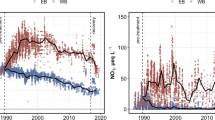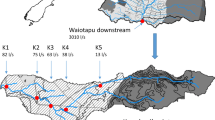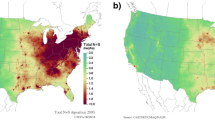Abstract
Decreased acid deposition over recent decades has led to reductions in streamwater acidity on a widespread basis throughout the U.S. and Europe. A notable exception has been the southern Appalachian Mountains of the southeastern U.S., where declines in acid deposition have not translated into similar trends in stream chemistry in these watersheds with highly-weathered soils. To better characterize this observed behavior, streamwater samples collected at 64 sites in western Virginia on a quarterly basis from 1987 to 2011 were analyzed for chemical properties. Individual watershed response was strongly influenced by the dominant underlying bedrock, which affected sulfate (\( {\text{SO}}_{4}^{2 - } \)) adsorption and base cation supply. Overall, pH increased at a majority of sites across all bedrock types. However, acid neutralizing capacity (ANC) decreased at most sites underlain by base-poor bedrock, suggesting the susceptibility to episodic acidification remains a serious threat to these streams. The declines in ANC were more closely related the depletion of base cations (Ca2+, Mg2+, K+, and Na+) rather than increased \( {\text{SO}}_{4}^{2 - } \) concentration. Sites with higher relative \( {\text{SO}}_{4}^{2 - } \) adsorption exhibited little change in ANC. A mass balance analysis of sulfur at a base-poor watershed revealed that exports have recently surpassed inputs for the first time within the several-decade period of record. This pattern appears likely to continue, and if sustained, the depletion of the stored pool of sulfur signifies an important precursor for further improvements in streamwater acidity in the region.







Similar content being viewed by others
References
Alewell C, Manderscheid B, Meesenburgz H, Bittersohl J (2000) Is acidification still an ecological threat? Nature 407:856–857
American Public Health Association (APHA) (1985) Method 403: Alkalinity—standard methods for the examination of water and wastewater, 16th edn. American Public Health Association, New York
American Public Health Association (APHA) (1998) Method 4500-H+B: pH value in water by potentiometry—standard methods for the examination of water and wastewater, 20th edn. American Public Health Association, New York
ASTM (2003) Annual book of ASTM standards, section 11: ASTM Method D 6919–03: determination of dissolved alkali and alkaline earth cations and ammonium in water and wastewater by ion chromatography. ASTM International, West Conshohocken
Baker JP, Van Sickle J, Gagen CJ et al (1996) Episodic acidification of small streams in the northeastern United States: effects on fish populations. Ecol Appl 6(2):422–437
Bulger AJ, Cosby BJ, Webb JR (2000) Current, reconstructed past, and projected future status of brook trout (Salvelino fontinalis) streams in Virginia. Can J Fish Aquat Sci 57:1515–1523
Byun D, Ching J (1999) Science algorithms of the EPA Models-3 community multi-scale air quality (CMAQ) modeling system. EPA-600/R-99/030. US EPA, US Government Printing Office, Washington, DC
Chao TT, Harward ME, Fang SC (1962) Adsorption and desorption phenomena of sulfate ions in soils. Soil Sci Soc Am J 26:234–237
Chestnut LG, Mills DM (2005) A fresh look at the benefits and costs of the US acid rain program. J Environ Manage 77:252–266
Cosby BJ, Hornberger GM, Wright RF, Galloway JN (1986) Modeling the effects of acid deposition: control of long-term sulfate dynamics by soil sulfate adsorption. Water Resour Res 22:1283–1291
Cosby BJ, Ryan PF, Webb JR, Hornberger GM, Galloway JN (1991) Mountains of western Virginia. In: Charles DF (ed) Acid deposition and aquatic ecosystems: regional case studies. Springer, New York
Currie WS, Galloway JN, Shugart HH (1996) Watershed base-cation cycle dynamic modeled over forest regrowth in a central Appalachian ecosystem. Water Air Soil Pollut 89:1–22
Dentener F, Drevet J, Lamarque JF et al (2006) Nitrogen and sulfur deposition on regional and global scales: multimodel evaluation. Global Biogeochem Cy. doi:10.1029/2005GB002672
Donahue WF, Schindler DW, Page SJ, Stainton MP (1998) Acid-induced changes in DOC quality in and experimental whole-lake manipulation. Environ Sci Techol 32:2954–2960
Driscoll CT, Fuller RD, Schecher WD (1989) The role of organic acids in the acidification of surface waters in the Eastern US. Water, Air, Soil Poll 43:21–40
Driscoll CT, Likens GE, Church MR (1998) Recovery of surface waters in the northeastern U.S. from decreases in atmospheric deposition of sulfur. Water Air Soil Pollut 105:319–329
Epa US (1987) Handbook of methods for acid deposition studies: laboratory analysis for surface water chemistry. USEPA, EPA 600/4-87-026. Washington, D.C, US EPA
Evans C (2005) Modeling the effects of climate change on an acidic upland stream. Biogeochemistry 74:21–46
Evans CD, Cullen JM, Kopácek J et al (2001) Recovery from acidification in European surface waters. Hydrol Earth Syst Sci 5(3):283–297
Fenneman N (1928) Physiographic regions of the United States. Ann Assoc Am Geogr 18:261–353
Fernandez IJ, Rustad LE, Norton SA, Kahl JS, Cosby BJ (2003) Experimental acidification cause soil base-cation depletion at the Bear Brook Watershed in Maine. Soil Sci Soc Am J 67:1909–1919
Flebbe PA, Roghair LD, Bruggink JL (2006) Spatial modeling to project southern Appalachian trout distribution in a warmer climate. Trans Am Fish Soc 135(5):1371–1382
Galloway JN, Norton SA, Church MR (1983) Freshwater acidification from atmospheric deposition of sulfuric acid: a conceptual model. Environ Sci Technol 17:541A–545A
Gran G (1952) Determination of the equivalence point in potentiometric titrations. Part II. Analyst 77:661–671
Grieve I (1999) Effects of parent material on the chemical composition of soil drainage waters. Geoderma 90:49–64
Hemond HF (1990) Acid neutralizing capacity, alkalinity, and acid–base status of natural waters containing organic acids. Environ Sci Technol 24(10):1486–1489
Hirsch RM, Slack JR (1984) A nonparametric trend test for seasonal data with serial dependence. Water Resour Res 20(6):727–732
Hirsch RM, Slack JR, Smith RA (1982) Techniques of trend analysis for monthly water quality data. Water Resour Res 18(1):107–121
Houle D, Ouimet R, Couture S, Gagnon C (2006) Base cation reservoirs in soil control the buffering capacity of lakes in forested catchments. Can J Fish Aquat Sci 63(3):471–474
Johnson DW, Todd DE (1990) Nutrient cycling in forests of Walker Branch Watershed: roles of uptake and leaching in causing soil change. J Environ Qual 19(1):97–104
Johnson DW, Henderson GS, Todd DE (1988) Changes in nutrient distribution in forests and soils of Walker Branch watershed, Tennesee, over an eleven-year period. Biogeochemistry 5(3):275–293
Kowalik RA, Ormerod SJ (2006) Intensive sampling and transplantation experiments reveal continued effects of episodic acidification on sensitive stream invertebrates. Freshwater Biol 51:180–191
Lien L, Raddum GG, Fjellheim A, Henricksen A (1996) A critical limit for acid neutralizing capacity in Norwegian surface waters, based on new analyses of fish and invertebrate responses. Sci Total Environ 177:173–193
Mitchell MJ, Likens GE (2011) Watershed sulfur biogeochemistry: shift from atmospheric deposition dominance to climatic regulation. Environ Sci Technol 25:5267–5271
Monteith DT, Stoddard JL, Evans CD et al (2007) Dissolved organic carbon trends resulting from changes in atmospheric deposition chemistry. Nature 450:537–540
National Atmospheric Deposition Program (NRSP-3) (2012) NADP Program Office, Illinois State Water Survey, 2204 Griffith Dr., Champaign, IL 61820
Prechtel A, Alewell C, Armbruster M et al (2001) Response of sulphur dynamics in European catchments to decreasing sulphate deposition. Hydrol Earth Syst Sci 5(3):311–326
Reuss JO, Johnson DW (1986) Acidic deposition and the acidification of soils and waters. Springer, New York
Rochelle BP, Church MP, David MB (1987) Sulfur retention at intensively studied sites in the U. S. and Canada. Water Air Soil Pollut 33:73–83
Runkel RL, Crawford CG, Cohn TA (2004) Load Estimator (LOADEST): A FORTRAN program for estimating constituent loads in streams and rivers: U.S. Geological Survey Techniques and Methods Book 4, Chapter A5, p. 69
SanClements MD, Oelsner GP, McKnight DM, Stoddard JL, Nelson SJ (2012) New insights into the source of decadal increases of dissolved organic matter in acid-sensitive lake of the northeastern United States. Environ Sci Technol 46:3212–3219
Sen P (1968) On a class of aligned rank order tests in two-way layouts. Ann Math Stat 39:1115–1124
Singh B (1984) Sulfate sorption by acid forest soils: sulfate adsorption isotherms and comparison of different adsorption equations in describing sulfate adsorption. Soil Sci 138:189–197
Skjelkvåle BL, Stoddard JL, Jeffries DS et al (2005) Regional scale evidence for improvements in surface water chemistry 1990–2001. Environ Pollut 137:165–176
Sokolova TA, Alekseeva SA (2008) Adsorption of sulfate ions by soils (a review). Eurasian Soil Sci 41:158–167
Stoddard JL, Driscoll CT, Kahl JS, Kellogg JH (1998) Regional analysis of lake acidification trends for the northeastern U.S., 1982–1992. Environ Monit Assess 51:399–413
Sullivan TJ, Webb JR, Snyder KU, Herlihy AT, Cosby BJ (2007) Spatial distribution of acid-sensitive and acid-impacted streams in relation to watershed features in the southern Appalachian Mountains. Water Air Soil Pollut 182:57–71
Sullivan TJ, Cosby BJ, Webb JR, Dennis RL, Bulger AJ, Deviney FA (2008) Streamwater acid–base chemistry and critical loads of atmospheric sulfur deposition in Shenandoah National Park, Virginia. Environ Monit Assess 137:85–99
Turner RS, Cook RB, van Miegroet H, et al (1990) Watershed and lake processes affecting chronic surface water acid–base chemistry. State of the Science, SOS/T 10. National Acid Precipitation Assessment Program. Washington, DC
U.S. EPA NERL (National Exposure Research Laboratory) [formerly EMSL] (1971) Methods for the chemical analysis of water and wastes (MCAWW) (EPA/600/4-79/020): Calcium by Flame AA (Method 215.1), Magnesium by Flame AA (Method 242.1), Potassium by Flame AA (Method 258.1), Sodium by Flame AA (Method 273.1); U.S. EPA; EPA/600/4-79/020
U.S. EPA Office of Ground Water and Drinking Water/Technical Support Center (1997) Methods for the determination of organic and inorganic compounds in drinking water, Volume 1 (EPA/815-R-00-014): EPA Method 300.1: Determination of inorganic anions in drinking water by ion chromatography; U.S. EPA; EPA/815-R-00-014
Virginia Department of Forestry. (2005) Forest cover map 2005: level 2 classification. http://DN9RS81/C$/vfcm/delivery/vfcm05_level2. Accessed 16 Januray 2012
Webb JR (2004b) Effects of acid deposition on aquatic resources in the central Appalachian Mountains. A Shenandoah Watershed Study Report. NPS
Webb JR, Cosby BJ, Galloway JN, Hornberger GM (1989) Acidification of native brook trout streams in Virginia. Water Resour Res 25:1367–1377
Webb JR, Cosby BJ, Deviney FA, Eshleman KN, Galloway JN (1995) Change in the acid–base status of Appalachian Mountain catchments following forest defoliation by the Gypsy Moth. Water Air Soil Pollution 85:535–540
Webb JR, Cosby BJ, Deviney FA, Galloway JN, Maben SW, Bulger AJ (2004) Are brook trout streams in western Virginia and Shenandoah National park recovering from acidification? Environ Sci and Tech 38:4091–4096
Wigington PJ, Baker JP, DeWalle DR et al (1993) Episodic acidification of streams in the northeastern United States: chemical and biological results of the Episodic Response Project. EPA/600/R-93/190, U.S. Environmental Protection Agency, Washington, D.C., USA
Acknowledgments
Support for this study was provided by the U.S. Environmental Protection Agency, the National Park Service, the USDA Forest Service, the Virginia Department of Game and Inland Fisheries, Trout Unlimited, the Appalachian Stewardship Foundation, and NSF Grant EAR-0645697. This paper has not been subjected to agency review and no official endorsement by any agency should be inferred. This paper is a contribution to the Shenandoah Watershed Study. We thank Suzanne Maben, Michael Pace, and Karen Rice for their input and help throughout this investigation.
Author information
Authors and Affiliations
Corresponding author
Additional information
Responsible Editor: R. Kelman Wieder
Rights and permissions
About this article
Cite this article
Robison, A.L., Scanlon, T.M., Cosby, B.J. et al. Roles of sulfate adsorption and base cation supply in controlling the chemical response of streams of western Virginia to reduced acid deposition. Biogeochemistry 116, 119–130 (2013). https://doi.org/10.1007/s10533-013-9921-6
Received:
Accepted:
Published:
Issue Date:
DOI: https://doi.org/10.1007/s10533-013-9921-6




